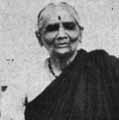Manikyamma : The Devaganika from Godavari
Manikyamma Saride, nearing 80 is one of the fortunate ones from the clan of Devadasis who were left to the mercy of fate after the Government abolished the system and tradition of Devadasis which was prevalent in the Hindu temples in some parts of India.
Winner of the 1991 Sangeet Natak Akademi award, Manikyamma was initiated as a temple dancer at the age of 11.
In the middle era with the rise of various sects within the fold of Hinduism, dancing was used a devotional act which in turn inspired many families to dedicated atleast daughter to the temple. These young “volunteers’ first underwent a solemn rite of investiture during a special ceremony.
After initiation, the girls were given the titles of Devadasis in the Tamil area of South. Similarly in Orissa they were called Maharis. In Andhra and some other areas, the nomenclature of Devdasis was rejected as it undermined the status of the ones who served God. So they were called Devaganikas – literally means: Divine courtesan.
The Devaganikas were required to undergo a rigid training, spend all their time within the temple precincts (except during special occasions) and never allowed to get married. In fact, they were married to the presiding deity of the temple.
Although initiated at the ate of 11, Manikyamma had commenced her dance initiation at the tender age of 5 under the tutelage of her grandmother Seshamma, her two paternal aunts who were Devadasis and her father who was a nattuvanar.
It was Purghallasubbaiha, a music and dance scholar and the temple guru, who introduced Manikyamma to abhinaya and |Adhyatma Ramayana. She continued with her tradition and danced in the Ballipadu Madanagopala temple in the Godavari district to which she was dedicated during her initiation.
The abolition of the Devadasi system had a great and traumatic impact on Manikyamma as on many others in the tradition who were left in lurch, deprived of their old patronage on one hand, and the Government’s negligence on the other.
Manikyamma left and moved to a nearby village, Duva, after losing the battle in the court against abolition of the Devadasi system. She left for economic reasons and perhaps more than that for the spiritual deprivation. She was no longer allowed to serve her beloved deity.
It was in 1972 that Dr. Nataraja Ramakrishna discovered the gifted Devaganika Manikyamma and persuagted her to teach the dying tradition to young disciples under the auspices of Andhra Sangeet Natak Academy.
The IGNCA with the cooperation of Dr. N. Ramakrishna and Dr. Premlata Sharma, a well known musicologist, managed to record Manikyamma’s abhinaya of the slokas of Adhyatma Ramayana in Varanasi during October 1989. During nine hours of the video documentation Manikyamma relieves the legend of the great Hindu epic by her lucid expression. Her transgression from one character to the other is fluid, yet so clearly defined that visions of a particular episode are vividly conjured up before the audience.
Adhyatma Ramayana
The Telugu version of Adhyatma Ramayana was written by Munpalli Subramanya Kavi, an emiment scholar, poet and musician in the Nayana court of Kalahasti Maharaj, Shri Raja Damera Kumara Venkatappa in the 14-15th century.
Theoretically, an integral part of the Brahmanand Purana, Adhyatma Ramayana is a retelling of the story of Ramayana. From a definite philosophical and theological standpoint, it is the abreviated version of the Valmiki Ramayana with various divergencies. The Telugu version has considerable deviations from its Sanskrit counterpart, rendered by the poet to suit the cultural ethod of the Andhra people. The work was composed essentially for singing, but the text was so appealing that it was interpreted into classical dance and presented as such by Manikyamma Saride.
[ Newsletter | List of Newsletter ]





